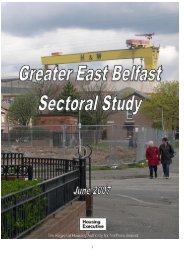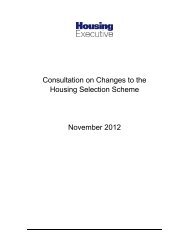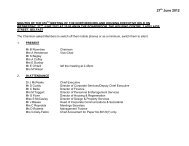House Price Index for Quarter 1 2013 - Northern Ireland Housing ...
House Price Index for Quarter 1 2013 - Northern Ireland Housing ...
House Price Index for Quarter 1 2013 - Northern Ireland Housing ...
You also want an ePaper? Increase the reach of your titles
YUMPU automatically turns print PDFs into web optimized ePapers that Google loves.
2<br />
<strong>Northern</strong> <strong>Ireland</strong> <strong>Quarter</strong>ly <strong>House</strong> <strong>Price</strong> <strong>Index</strong><br />
<strong>Northern</strong> <strong>Ireland</strong>’s housing market:<br />
prospects <strong>for</strong> <strong>2013</strong> and beyond<br />
University of Ulster’s quarterly analysis of house prices in<br />
<strong>Northern</strong> <strong>Ireland</strong> <strong>for</strong> quarter 1, <strong>2013</strong> would indicate that the<br />
housing market is rather like the proverbial curate’s egg: good<br />
in parts. The further increase in the number of transactions<br />
and the increase of 1.9 per cent in the weighted average price<br />
of homes compared to quarter 1, 2012 are to be welcomed as<br />
further indications of a stabilising market. However, it is always<br />
important to put these developments in the context of wider<br />
economic and demographic fundamentals.<br />
The <strong>Housing</strong> Executive’s latest annual analysis of the housing<br />
market and its drivers (<strong>Northern</strong> <strong>Ireland</strong> <strong>Housing</strong> Market: Review<br />
& Perspectives <strong>2013</strong>-2016) does this by providing a synthesis of<br />
the most recent housing statistics and examining likely trends<br />
over the next three year period.<br />
The world economy is an important underlying determinant<br />
of developments in <strong>Northern</strong> <strong>Ireland</strong>’s housing market – above<br />
all because of the impact of developments in the world economy<br />
on the financial system and the propensity of banks / building<br />
societies to lend to potential homebuyers and investors. Analysis<br />
by the International Monetary Fund (IMF) in its World Economic<br />
Outlook Update (January <strong>2013</strong>) indicates that the world economy<br />
is expected to grow by 3.5 per cent in <strong>2013</strong>, a slightly higher rate<br />
than in 2012 (3.2%), if the euro area recovers. However,<br />
the expected upturn will be more gradual than in its<br />
October 2012 projections.<br />
In the USA, a “supportive financial market environment”, has been<br />
reflected in a significant increase in housing market activity and<br />
a reduction in the level of household debt. The biggest threat to<br />
world economic recovery comes from the sovereign debt crisis and<br />
the related economic crisis in the euro area. The IMF estimates<br />
that the euro area’s economy shrank by 0.4 per cent in 2012 and<br />
will continue to do so in <strong>2013</strong> (by -0.2%). The most recent banking<br />
crisis which emerged in Cyprus in March <strong>2013</strong> confirms that bank<br />
liquidity is still a major issue and would indicate that prolonged<br />
stagnation in the euro area is a very real possibility.<br />
The United Kingdom is experiencing the slowest post-recession<br />
recovery in its economy since the nineteenth century. Against<br />
this background and in the context of a continued Government<br />
commitment to austerity, in order to achieve further reductions in<br />
the budget deficit, the Chancellor announced what the Institute<br />
<strong>for</strong> Fiscal Studies characterised as a fiscally neutral budget on 21st<br />
March <strong>2013</strong>. The Office <strong>for</strong> Budgetary Responsibility (OBR) revised<br />
its <strong>for</strong>ecast <strong>for</strong> GDP growth in <strong>2013</strong> downwards from the 1.2 per<br />
cent (in December 2012’s Autumn Statement) to 0.6 per cent.<br />
<strong>Northern</strong> <strong>Ireland</strong>’s labour market remains uncertain<br />
(approximately one third of all people of working age are<br />
workless – the highest <strong>for</strong> any UK region) and real household<br />
incomes are falling – a position which may well be exacerbated<br />
by welfare re<strong>for</strong>m. Economic uncertainty is reflected in a more<br />
cautious approach by banks and building societies to prospective<br />
borrowers. Further public expenditure reductions may impact in<br />
a disproportionate way in <strong>Northern</strong> <strong>Ireland</strong>, where approximately<br />
one third of all employment is in the public sector and two thirds<br />
of GDP is dependent on it.<br />
The Review and Perspectives also notes that the underlying<br />
demographic driver of the housing market – the rate of household<br />
<strong>for</strong>mation - has slowed. Figures which emerged from the 2011<br />
Census showed that while population projections <strong>for</strong> 2011 had<br />
been very accurate, a slowing rate of household <strong>for</strong>mation<br />
– primarily as a result of the difficult economic environment –<br />
meant that there were approximately 12,000 fewer households<br />
than had been <strong>for</strong>ecast by the 2008-based household projections,<br />
something which is undoubtedly reflected in the demand<br />
<strong>for</strong> housing.<br />
Lack of effective demand has meant that private sector<br />
construction remains at a low level: around 4,500 new dwellings<br />
were constructed <strong>for</strong> the private sector in 2011/12 and early figures<br />
indicate a similar figure <strong>for</strong> 2012/13. The number is unlikely to<br />
increase much above this over the coming three year period.<br />
Co-Ownership has continued to play a valuable bridging role in<br />
enabling households on low incomes each year to become home<br />
owners. New funding commitments given by Government and<br />
lenders in November 2012 will enable Co-Ownership to secure<br />
an estimated 2,500 af<strong>for</strong>dable homes over a four year period.<br />
Almost one in five of all properties are now in the private rented<br />
sector, a tenure which is playing an increasingly important role<br />
in meeting the accommodation needs of younger households<br />
aspiring to become first-time buyers in the future and households<br />
on lower incomes, who in previous decades would have found<br />
suitable accommodation in the social sector. The continuation<br />
of direct payment of <strong>Housing</strong> Benefit to landlords in <strong>Northern</strong><br />
<strong>Ireland</strong> is seen as a major contributory factor to sustaining the<br />
viability of the sector in the longer term.<br />
The final document which will be launched on 16 May <strong>2013</strong><br />
indicates that prospects <strong>for</strong> <strong>Northern</strong> <strong>Ireland</strong>’s housing market<br />
over the next three years are there<strong>for</strong>e mixed. <strong>Price</strong>s may well<br />
drift down a little more – particularly in more peripheral areas<br />
where the labour market tends to be at its weakest. However,<br />
unless there is another major financial crisis or the world economy<br />
really fails to recover, it is very unlikely that there will be any<br />
further significant downturn in house prices in <strong>Northern</strong> <strong>Ireland</strong>.<br />
Joe Frey<br />
Head of Research, NIHE<br />
T: 02890 318540<br />
E: joe.frey@nihe.gov.uk

















